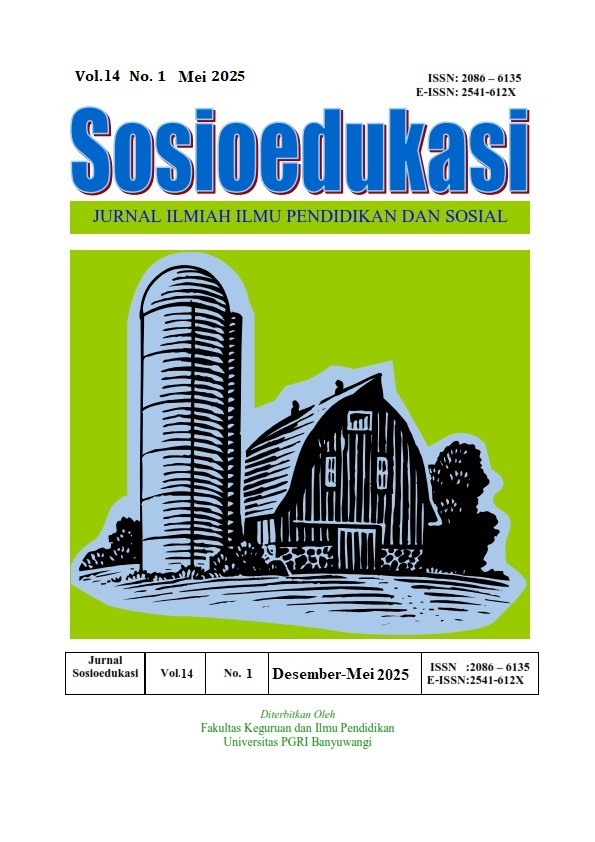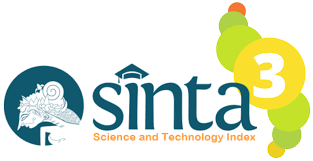THE USE OF KOMPAS IN DETERMINING THE ACCURACY OF QIBLA DIRECTION (CASE STUDY ON MOSQUES IN SERDANG BEDAGAI REGENCY)
DOI:
https://doi.org/10.36526/sosioedukasi.v14i1.5701Keywords:
Accuracy, Compass, Qibla Direction, MosqueAbstract
This study aims to examine the level of accuracy of the direction of the Qibla in several mosques in Serdang Bedagai Regency which is determined using a compass, by comparing it to the direction of the Qibla calculated astronomically using geographic coordinate data and the help of GPS-based digital applications (such as Google Earth). The scholars agree that people who can see the Kaaba directly must face the Kaaba building ('ainul Kaaba). However, for people who are outside the Grand Mosque, especially far from Mecca, it is sufficient to face the Kaaba (Jihah Kaaba). Determining the accurate direction of the Qibla is important in carrying out Islamic prayers. In various regions, including Serdang Bedagai Regency, the method commonly used by people to determine the direction of the Qibla is using a compass. However, the accuracy of the compass is often influenced by environmental factors such as local magnetic fields and inaccuracy in use. This study uses an empirical Islamic legal research method (non-doctrinal research), a legal research method that functions to see how the law works in society. The object of the study is the direction of the Qibla from mosques in Serdang Bedagai Regency, totaling 665 mosques which are the research population. The sample in this study was 17 mosques from several sub-districts using the Purposive Sample technique which is a non-random sampling technique, with the vastness of Serdang Bedagai Regency and the large number of mosques requiring researchers to conduct non-probability sampling. In addition, researchers also conducted interviews. The results of the study showed that there was a deviation in the direction of the Qibla in most mosques with an average difference of 2° to 25° from the actual direction. This shows that the use of a compass manually without calibration and consideration of local factors can cause inaccuracy in determining the direction of the Qibla. This study recommends the use of more precise methods such as GPS devices, digital applications, or observations of the position of the sun during Rashdul Qiblah, especially for the construction of new mosques.
References
Al- Fairuzabadi, M. (2005). al-Qamus al-Muhit. Muassasah Risalah.
Al- Syafi’i, M. al-A. al-H. (2001). Hadaiq Rauhi war Raihan. Dar Tauq wan Najah.
Alamsyah, M. F., Hambali, Y., & Ash Shabah, M. A. (2022). Webinar Mengenai Konsep Ilmu Falak dan Mempraktekkan Tata Cara Menghitung Arah Kiblat. Al-Ihsan: Journal of Community Development in Islamic Studies, 1(1), 32–37. https://doi.org/10.33558/alihsan.v1i1.4594
Amin, Y., & Sutopo, S. (2022). Uji Akurasi Arah Kiblat Masjid Pondok Pesantren Sunan Drajat Kecamatan Paciran Kabupaten Lamongan dengan Metode Mizwala Qibla Finder. JOSH: Journal of Sharia, 1(1), 67–80. https://doi.org/10.55352/josh.v1i1.154
Amir, R. (2020). Kalibrasi Arah Kiblat Masjid di Kecamatan Makassar Kota Makassar. ELFALAKY: Jurnal Ilmu Falak, 4(2), 20–37. https://doi.org/10.24252/IFK.V4I2.20747
Ansori, M., & Ali, S. (2022). Penentuan Arah Kiblat Menggunakan Rubu’ Mujayyab (Study Penelitian di Masjid An-Nur Pare) . El-Faqih : Jurnal Pemikiran Dan Hukum Islam, 8(1), 131–148. https://doi.org/10.29062/FAQIH.V8I1.473
Arifin, N. (2020). Integrasi Teks-Teks Syar’i yang Terkait dengan Arah Kiblat dalam Konteks Astronomi. ELFALAKY: Jurnal Ilmu Falak, 4(1), 1–15. https://doi.org/10.24252/IFK.V4I1.14169
Bimasakti, A. Z., Akmal, A. M., & Bakar, S. A. (2023). Rasi Bintang dalam Penentuan Arah Mata Angin Perspektif Ilmu Falak. HISABUNA: Jurnal Ilmu Falak, 4(2), 1–21. https://doi.org/10.24252/hisabuna.v4i2.37112
Cahyani, A., Amir, R., & Chotban, S. (2022). Akurasi Arah Kiblat Masjid di Desa Manjalling Kecamatan Bajeng Barat Kabupaten Gowa. HISABUNA: Jurnal Ilmu Falak, 3(2), 142–160. https://doi.org/10.24252/hisabuna.v3i2.22800
Gimnastiyar, D. I., Baihaqi, M. I., & Hanafi, A. (2025). Preservasi dan Konservasi Manuskrip Tradisional di Kabupaten Jember: Studi Filologi dan Digitalisasi. Polyscopia, 2(1), 95–102. https://doi.org/10.57251/polyscopia.v2i1.1629
Hakim, L. (2023). Akurasi Arah Kiblat pada Pemakaman Se-Kota Salatiga. Al-Bayan: Jurnal Ilmu al-Qur’an Dan Hadist, 6(1), 137–159. https://doi.org/10.35132/ALBAYAN.V6I1.428
Harahap, A. W. H., Achiriah, A., & Harahap, N. (2024). Dinamika Penyebaran dan Perkembangan Islam di Desa Pagaran Bira Jae, Kabupaten Padang Lawas, Sumatera Utara. Local History & Heritage, 4(2), 122–126. https://doi.org/10.57251/lhh.v4i2.1329
Hasan, M., Hidayatullah, N. F., & Hidayatullah, N. F. (2022). Studi Arah Kiblat Pemakaman Muslim : Antara Praktek dan Teori. ELFALAKY: Jurnal Ilmu Falak, 6(1), 1–17. https://doi.org/10.24252/IFK.V6I1.31001
Hasjun, I., Kasim, A. J., & Putra, N. A. (2024). Uji Akurasi Hasil Pengukuran Arah Kiblat Pegawai Kemasjidan Kua Menggunakan Aplikasi Google Earth. Astroislamica: Journal of Islamic Astronomy, 3(1), 114–135. https://doi.org/10.47766/astroislamica.v3i1.2796
Helmi, R., & Badrian, B. (2024). Akurasi Arah Kiblat Masjid-Masjid di Kabupaten Banjar. Indonesian Journal of Islamic Jurisprudence, Economic and Legal Theory, 2(1), 215–227. https://doi.org/10.62976/ijijel.v2i1.439
Hijriah, N., & Anis, M. (2021). Eksistensi Ilmu Falak dalam Penentuan Arah Kiblat Kuburan (Studi Pemakaman Desa Labokong Kabupaten Soppeng). HISABUNA: Jurnal Ilmu Falak, 2(3), 118–131. https://doi.org/10.24252/hisabuna.v2i3.14662
Izzuddin, A. (2012). Ilmu Falak Praktis: Metode Hisab Rukyat Praktis dan Solusi Permasalahannya. Pustaka Rizki Putra.
Izzuddin, A., Rahman, M. H., & Riza, M. H. (2021). Teleskop Ioptron Cube II dalam Penentuan Arah Kiblat. AL - AFAQ : Jurnal Ilmu Falak Dan Astronomi, 3(1), 25–40. https://doi.org/10.20414/afaq.v3i1.2776
Jaib, S. A. (1988). Al-Qamus Al-Fiqhi Lughatan Wa Istilahan. Dal al-Fikr.
Khalifah, N. (2021). Eksistensi Ilmu Falak dalam Penentuan Arah Kiblat dan Awal Waktu Salat. HISABUNA: Jurnal Ilmu Falak, 2(1), 36–52. https://doi.org/10.24252/hisabuna.v2i1.17809
Khazin, M. (2005). Kamus Ilmu Falak. Buana Pustaka.
Nabilla, A., & Daulay, A. S. (2024). Determination of Secondary Metabolite Content of Phenolic Group from Liquid Smoke of Coconut Shell and Husk (Cocos nucifera L.) Using Visible Spectrophotometry. Science Midwifery, 12(5), 1817–1827. https://doi.org/10.1016/J.MEATSCI.2014.02.003
Nurqolbi DY, Y., Alpaten, U. A. A. A., & Kurniawan, K. (2024). Kajian Penentuan Arah Kiblat dengan Sensor Magnetik Kompas Android. Astroislamica: Journal of Islamic Astronomy, 3(2), 193–210. https://doi.org/10.47766/astroislamica.v3i2.3429
Pathuddin, H., Nurman, T. A., & Saleha, S. (2023). Perbandingan Rumus Trigonometri dan Metode Tongkat Istiwa’ untuk Mengakurasikan Arah Kiblat. Jurnal MSA ( Matematika Dan Statistika Serta Aplikasinya), 11(1), 12–19. https://doi.org/10.24252/msa.v11i1.34870
Qal’aji, M. R. (1988). Mu’jam Lughah al-Fuqaha. Darul al-Nafais.
Safitri, M. (2022). Studi Komparasi terhadap Akurasi Istiwaaini dengan Kompas Kiblat Android “Muslim Go” dalam Pengukuran Arah Kiblat. AL - AFAQ : Jurnal Ilmu Falak Dan Astronomi, 4(1), 78–94. https://doi.org/10.20414/afaq.v4i1.5070
Sriani, S. O., & Ukhti, L. (2022). Uji Akurasi Arah Kiblat Menggunakan Fitur Kompas Kiblat pada Aplikasi Quran Kemenag Versi 2.1.4. Astroislamica: Journal of Islamic Astronomy, 1(2), 213–231. https://doi.org/10.47766/astroislamica.v1i2.951
Subagyo, J. (2011). Metode Penelitian dalam Teori dan Praktik. Rineka Cipta.
Taman, B., Fauzan, A., Hermanto, D., Amin, A., & Suradi, S. (2024). Pendampingan Kalibrasi Arah Kiblat Pemakaman Pada Pengurus TPU Kota Bengkulu dengan Media “Qibla Triangle Bengkulu City.” DEDIKASI: Jurnal Pengabdian Masyarakat, 6(2), 111–126. https://doi.org/10.32332/RYASF087
Vidyana, I., Rismawan, T., & Hidayati, R. (2025). Sistem Pendeteksi Arah Kiblat bagi Disabilitas Menggunakan Sensor Kompas dan Global Positioning System (GPS). Jurnal Informatika Polinema, 11(3), 253–260. https://doi.org/10.33795/jip.v11i3.6832
Wakia, N., & HR, S. (2020). Meretas Problematika Arah Kiblat Terkait Salat di Atas Kendaraan. ELFALAKY: Jurnal Ilmu Falak, 4(2), 207–221. https://doi.org/10.24252/IFK.V4I2.18089
Yaqin, A., & Azmi, M. F. (2023). Pengukuran Arah Kiblat dalam Pengembangan Masyarakat Islam. ICODEV: Indonesian Community Development Journal, 4(2), 111–118. https://doi.org/10.24090/icodev.v4i2.9956









.png)

















